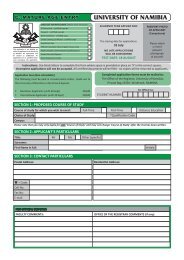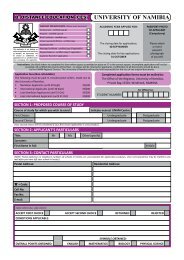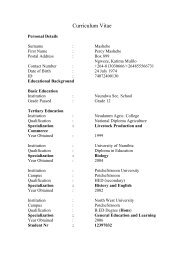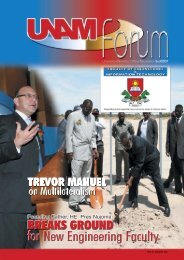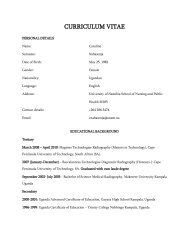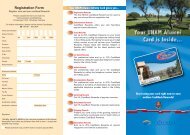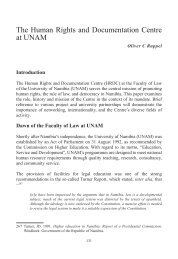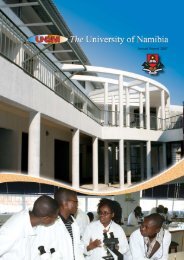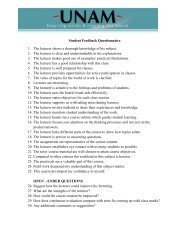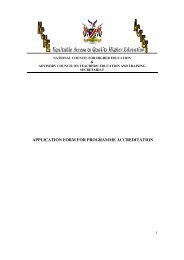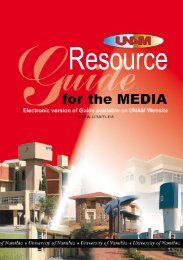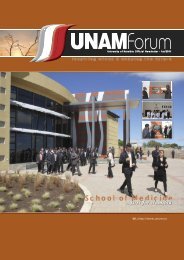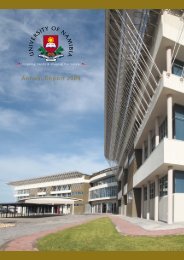UNIVERSITY OF NAMIBIA CENTRE FOR EXTERNAL STUDIES ...
UNIVERSITY OF NAMIBIA CENTRE FOR EXTERNAL STUDIES ...
UNIVERSITY OF NAMIBIA CENTRE FOR EXTERNAL STUDIES ...
You also want an ePaper? Increase the reach of your titles
YUMPU automatically turns print PDFs into web optimized ePapers that Google loves.
Content: An Introduction To Chemistry: Classification of Matter; The Three States of Matter; Physical and Chemical Properties ofMatter; Measurement; Handling Numbers (scientific notation, significant figures); Factor-Label Method in Solving Problems. Atoms,Molecules and Ions: The Structure of the Atom; Atomic Number, Mass Number, and Isotopes; Molecules and Ions; Chemical Formulas(molecular and empirical); Naming Compounds. Mass Relationships in Chemical Reactions: Atomic Mass; Avogadro’s Number andMolar mass; Molecular Mass; Percent Composition of Compounds; Experimental Determination of Empirical Formulas; ChemicalReactions and Chemical Equations; Stoichiometry (amounts of reactants and products); Limiting & Excess Reagents; Reaction Yield;Concentration of Solutions. Reactions in Aqueous Solutions: General Properties of Aqueous Solutions; Precipitation Reactions; Acid-Base Reactions; Oxidation and Reduction Reactions (assigning oxidation states, writing redox equations, balancing redox reactions).Quantum Theory and the Electronic Structure of Atoms: The Photoelectric Effect; Bohr’s Theory of the Hydrogen Atom; QuantumNumbers; Atomic Orbitals; Electron Configuration; The Building-up Principle. Periodic Relationships Among Elements: PeriodicClassification of the Elements; Periodic Variation in Physical Properties (effective nuclear charge, atomic radius, ionic radius); lonizationEnergy; Electron Affinity; Variation in Chemical Properties of the Representative Elements (main group elements). Chemical Bonding:Lewis Dot Symbols; Ionic Bonding; Covalent Bonding; Metallic Bonding; Electronegativity; Writing Lewis Structures; Formal Charge;Concept of Resonance; Bond Enthalpy. Basic Molecular Geometry and Hybridization of Atomic Orbitals: Molecular Geometry; DipoleMoments; Valence Bond Theory; Hybridization of Atomic Orbitals; Molecular Orbital Theory; Molecular Orbital ConfigurationsChemistry IBSCHM3512NQF Level: 5 Credits: 16 Module Assessment: CA 50% Examination 50% - 1 x 3 hour paperPrerequisite: Faculty Entry RequirementsModule description:This module is a continuation of Chemistry 1A and it introduces the students to properties of gases, thermochemistry, chemicalkinetics,chemical equilibrium, Introduction to laws of thermodynamics, electrochemistry and organic chemistry. The following topics arecovered:Content: Gases: Pressure of a Gas; The Gas Laws; The Ideal Gas Equation; Gas Stoichiometry; The Kinetic-Molecular Theory ofGases; Deviation from Ideal Behaviour. Basic Thermochemistry: The Nature of Energy and Types of Energy; Energy Changes inChemical Reactions; Introduction to Thermodynamics; Enthalpy of Chemical Reactions; Calorimetry; Standard Enthalpy of Formationand Reaction; Heat of Solution and Dilution. Introductory Chemical Kinetics: Rate of Reaction; Rate Law; Relation between ReactantConcentration and Time; Activation Energy and Temperature Dependence of Rate Constants; Reaction Mechanisms; Catalysis.Introduction to Chemical Equilibrium: The Equilibrium Constant; Writing Equilibrium Constant Expressions; Relationship betweenChemical Kinetics and Chemical Equilibrium; What Does the Equilibrium Constant tell Us? Factors that Affect Chemical Equilibrium.Acid-Base Equilibria & Solubilty Equilibria: The Common Ion Effect; Buffer Solution; Acid – Base Titrations; Acid-Base Indicators;Solubility Equilibria; Separation of Ions by Fractional Precipitation; The Common Effect and Solubility; pH and Solubility; Complex IonEquilibria and Solubility. Entropy, Free Energy and Equilibrium: The Three Laws of Thermodynamics; Spontaneous Processes; Entropy;The Second Law of Thermodynamics; Gibbs Free Energy; Free Energy and Chemical Equilibrium; Thermodynamics in Living Systems.Introduction to Electrochemistry: Galvanic Cells; Standard Reduction Potentials; Spontaneity of Redox Reactions; Effect ofConcentration of Cell EMF; Electrolysis. Introduction to Organic Chemistry: Classes of Organic Compounds; Structure andNomenclature Main Functional Groups (alkanes, alkenes, alkynes, alcohols, aldehydes, ketones, carboxylic acids, esters, amines,amides). Introduction to carbohydrates, lipids and porphyrins.Classical MechanicsSPHY3611NQF Level: 6 Credits: 16 Module Assessment: CA 50% Examination 50% - 1 x 3 hour paperPrerequisite: SPHY3511 Physics for Physical Sciences I, SMAT3511Basic Mathematics and SMAT3512 PrecalculusModule description:Vectors, vector operations & the calculus of vectors; straight line and general motion particles; polar co-ordinates; rigid bodies: rotatingabout a fixed axis & planar motion; reference frames; inertial frames and the law of inertia; Laws of: mutual interaction, multipleinteractions, universal gravitation; mass distributions; principle of equivalence; rectilinear motion in a force field; constrained rectilinearmotion; resisting media; projectiles; circular motion; classical SHM: damped & forced; coupled oscillations and normal modes; energyprinciple; rectilinear motion; conservative fields; orbits in a central field: orbital motion, path equation, Homann transfer orbits, attractive &repulsive inverse square fields; Rutherford scattering; non-linear oscillations and phase space; phase plane in dynamics; limit cycles;driven non-linear oscillations; degrees of freedom; rigid bodies; linear momentum; rocket motion; collision theory; zero-momentum frame;2-body problem; scattering; integrable mechanical systems; moment of a force; angular momentum; planar rigid body motion; Rigid bodystatics;Electricity and MagnetismSPHE3642NQF Level: 6 Credits: 8 Module Assessment: CA 50% Examination 50% - 1 x 3 hour paperPrerequisite: SPHY3512 Physics for Physical sciences II, SMAT351 Basic Mathematics, SMAT3512 Pre-calculus.176



